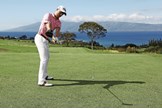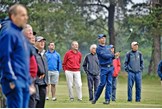To get better at golf, have an end result in mind
Published:
Tweaking your golf swing without having an end goal in mind is a recipe for disaster.
Judging by the bulging diaries my PGA professional colleagues have been showing me, it seems like the entire UK golfing community emerged from lockdown by taking a lesson. No harm in that, you might think.
And yet, it has set the alarm bells ringing. Lessons, of course, are generally a great idea. But they should always be based around what the ball is doing, and a clear objective for your shots. With no recent history on which to base a direction for this work and no clear objective in place, lessons could be a dangerous course. Let me explain why.
RELATED Should Golf Pros Really Be Our Role Models?

Club golfers tend to ask: “What’s wrong with my swing?” Sounds innocent enough, but this is, in fact, one of golf’s more treacherous questions. For starters, it will tend to get you into a fairly futile discussion on style – how your backswing looks, how your legs work, how it all compares to Dustin… or Bryson… or any other tour pro you care to mention. But “What’s wrong with my swing? ” is also an open invitation for you to apply any and every tip out there, and the starting point for losing your game under a pile of well-meaning, probably contradictory and often-irrelevant golf tips.
A far better question to ask is “What’s wrong with my shot?” This sets off a far more targeted and effective chain of events, one based around what you are trying to do with the golf ball, and what technique you might need to help you hit those shots. Let’s see how this works in practice.
RELATED Make A Better Start To Your Round Of Golf
You are a right-handed golfer who slices the ball. When you ask yourself “What’s wrong with my swing?” you could go off in any number of directions, never really understanding if the path you’ve chosen is the correct one and where it will ultimately lead you. But ask “What’s wrong with my shot?” and a precise, clear picture emerges; the ball starts left of target before cutting off to the right. To remedy that, you might consider learning to hit a soft draw, and training the technique that would accomplish that. What would you need to do with the club? What skills do you need to develop to start the ball to the right?
In his extremely successful book The 7 Habits of Highly Effective People, Stephen Covey discusses the principle of ‘Starting with the end in mind’. That’s essentially what you’re doing here. There is always an end point, a direction. It makes for a far better process than chasing the shadows created by swing plane, weight shift and all the other technical ‘desirables’ that form the swing-first approach.
So let us suppose we have taken the enlightened approach and worked on the shot, not the swing. There is still a technical change to be achieved. What is the best way to adopt it without compromising performance?
I have talked many times about internal focus – thinking about part of the body during the swing – and external focus, for example the club, the ball or the target. You might think that for a technical change – altering a physical movement pattern – an internal bodily focus would be more appropriate. In fact scientific research suggests external focus, for example considering how the club needs to move to hit that draw, remains more effective. This is, however, a broad brushstroke. If external focus is not getting you into the positions to hit the shots you want, go to internal thoughts. There is a time and a place for them.
RELATED Lower Your Golf Score In 5 Easy Steps
As your new moves become more familiar and effective in practice, you will be tempted to put them into play in competition. The golden rule here is to play with where you’re at. Ask yourself “What have I got today?” If you are trying to turn a slice into a draw, but the ball is still fading, play with your fade. This will free you to focus on the shot and play the game, and perform as well as you can on the day. Padraig Harrington is one of golf’s most committed technicians, but he has often talked about how he has never taken a swing thought on to the golf course. It’s a fine example to follow.

When you do eventually bring a new move on to the course, prime it during rehearsal, not the swing itself. Think about Justin Thomas’ takeaway check (below), a preparatory move that he uses almost as a cue for the shot.
Take care of the move in rehearsal and leave your action to take care of itself.
It’s the key to making your best effort every time. So, to sum up…
1. Focus on what you are trying to do with the shot, not with your golf swing.
2. As you work on the technique, try an external focus before trying internal cues.
3. During the transitional phase, go with what you have on the day.
4. Train new moves during rehearsal, not the shot itself.
READ NEXT How to cope when your form deserts you


